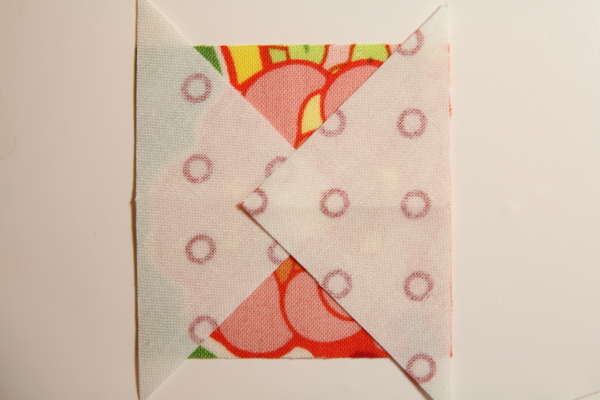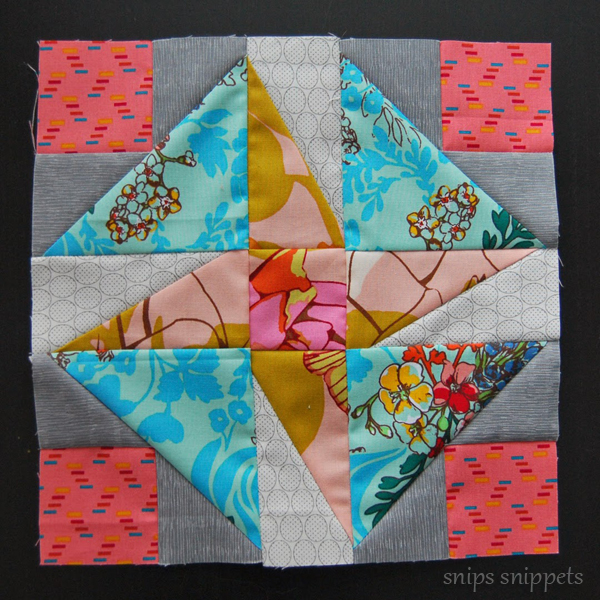section two components
all measurements are cut/unfinished, not finished
blocks
9.5” Pershing, pg 6
7.5” courthouse steps, pg 20
6.5” sq in sq (4.5”), bordered, pg 22/23
2 – 3.5” sq in sq, pg 22
8.5” old maid puzzle, pg 17
strips
H – 8.5”
I – 8.5”
47 – 8.5”
53 – 7.5”
54 – 7.5”
55 – 19.5” (optional 7.5” if you are piecing this strip to avoid partial seams)
before we get into the blocks, i'm going to reiterate some things i have found helpful as i have worked on more of the larger blocks for this section:
- gypsy wife is a great exercise in accuracy. that's how i approach this quilt when i sit down to make it. i don't hold myself to perfection standards, but i do take my time with each block as a mini project, allowing myself to go slow and focus on improving my accuracy.
- trim as you go. i figure out what each component size should be, overcut my pieces a bit, then trim after sewing and pressing.
- carefully press each component of the block as you make it, not all at the end. carefully press - i'm amazed how quickly i can get distortion in blocks with so many parts and pieces.
- work on your scant 1/4" seam. it will really help the blocks come out the right size. even 1/4" feet are not always accurate, so check the accuracy of your foot and figure out where your scant 1/4" seam is, as well. it seems fussy, but it's helpful.
- again, give yourself time and space to work on each piece individually, if you can. i find it so much more enjoyable when i focus on all the mini projects included in this quilt. it's not unusual for me to spend an entire sewing session/evening on one large block. as i like to say, "little quilting chores make for big quilting finishes." this is a quilt of lots and lots of parts. one step at a time, one block at a time, we will get a gypsy wife quilt made!
so, about this month's section two - it's not a big section, but there is plenty of challenge contained in these few blocks, particularly in the pershing block, which some regard as the most difficult or time-consuming in the quilt. don't let that scare you away! just set aside an evening or chunk of time when you can focus on slowly working your way through this block with accuracy. megan has made a detailed tutorial of her process with this block on her blog, jaffa quilts. she has also included a link to a paper piecing pattern for pershing, if you would rather go that route.
 |
| pershing |
i do need to add a funny note here. for the longest time, my brain was filling in a missing letter in this block's name and i was calling it "perishing." i thought it was so named because you'd want to "perish" after completing it! but, actually, it was named after the block-designer's husband, "pershing." what an unusual first name! i discovered my mistake a few months ago when i read a small essay on the history of this block in a book or magazine. the block was designed for a newspaper contest, and when the maker was pressed for a name, she chose her husband's. i wish i had the details, but i've looked and looked through my considerable library and been unable to find the original information. you'll just have to take my word for it.
megan quite likes my name and finds it appropriate. she also likes how i've renamed "puss in the corner" to "kitty in the corner." does that make me a true quilter, my renaming and modifying traditional blocks?
 |
| 7.5" courthouse steps block, left, being substituted with a 7.5" bordered sq-in-sq block, right |
also, the block itself is slightly modified because i had to make adjustments when my fabric fell short. those red corners aren't part of the pattern. but that's the lovely thing about this pattern - there is lots of room for modifying within the original frame work. in fact, i'll soon be posting about working with blocks that are the wrong size.
 |
| sq-in-sq blocks for section two |
there are three sq-in-sq blocks in this section: 2 - 3.5" blocks and 1 - 6.5" bordered. again, my block is going to look slightly different from yours here because i used a 3.5" sq-in-sq block in the center of my 6.5" bordered block, rather than the 4.5" sq-in-sq called for. this had to do with laziness on my part of wanting to use a block i had already made rather than making another at the time. however, i think it would have looked better had i used a larger block in the center. but it's done and staying as is. (if you missed my tutorials for an alternate construction method for the sq-in-sq blocks, find the 3.5" here and the 4.5" here.)
 |
| old maid's puzzle |
the final block for section two is "old maid's puzzle." this is another interesting and enigmatic name for a block, and i wish i knew it's history. there are two of these blocks in this quilt, the other falling in section eight, later on. many versions of this block go completely scrappy on the triangles. i meant to do that this time around after i was uniform in the fabric selection for my last version of the block, but i forgot. and so here is my second matchy-matchy block. i'll be sharing a detailed tutorial of the process for this block later this week.
section two falls directly below/south of section one in the quilt, so you will be using some of the same strips from last month again. if you opted to piece strip 55 instead of use a partial seam (which megan showed us are actually not scary at all), then please make note of the adjusted optional length for that strip in section two.
work ahead options
if you just can't stop with the blocks, the next two sections are mighty small - so small we've lumped them together for april's schedule. so you can either go for section three or four, or get a jump start on the largest section, section six (june) by making some of the sq-in-sq blocks or other basic blocks for that section. since they fall below sections one and two, you will know what strips they will be set in, which will help with color choices.
section three – april
blocks
5.5” sq in sq (3.5”), bordered, pg 22/pg 23
4.5 sq in sq, pg 22
10.5” sq in sq w/ courthouse steps, pg 23-24
9.5” Colour wheel, pg 5
strips
28 – 9.5”, 8.5”
29-33 – 3.5”
34-37 – 3.5”, 1.5”
section four – april
8.5” courthouse steps, pg 20
8.5” hst block, pg 16
a lot, i would say most, of the activity for our quilt along is happening over on instagram. here are some of the hashtags you can search to follow along:




















































